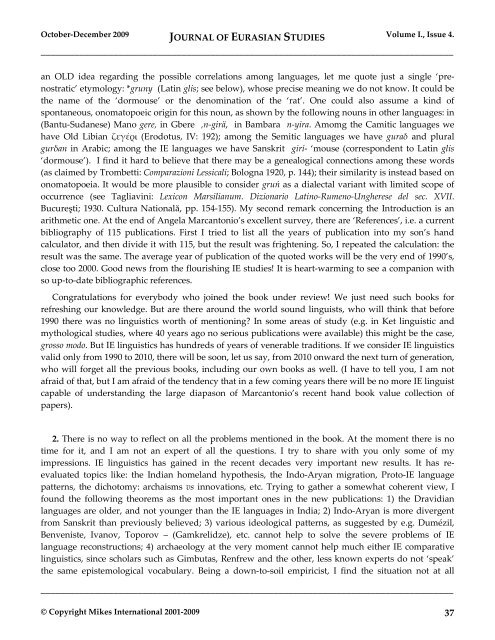JOURNAL OF EURASIAN STUDIES
JOURNAL OF EURASIAN STUDIES
JOURNAL OF EURASIAN STUDIES
Create successful ePaper yourself
Turn your PDF publications into a flip-book with our unique Google optimized e-Paper software.
October-December 2009 <strong>JOURNAL</strong> <strong>OF</strong> <strong>EURASIAN</strong> <strong>STUDIES</strong> Volume I., Issue 4.<br />
_____________________________________________________________________________________<br />
an OLD idea regarding the possible correlations among languages, let me quote just a single ‘prenostratic’<br />
etymology: *gruny (Latin glis; see below), whose precise meaning we do not know. It could be<br />
the name of the ‘dormouse’ or the denomination of the ‘rat’. One could also assume a kind of<br />
spontaneous, onomatopoeic origin for this noun, as shown by the following nouns in other languages: in<br />
(Bantu-Sudanese) Mano gere, in Gbere ,n-girä, in Bambara n-yira. Amomg the Camitic languages we<br />
have Old Libian ζεγέρι (Erodotus, IV: 192); among the Semitic languages we have guraδ and plural<br />
gurδan in Arabic; among the IE languages we have Sanskrit girí- ‘mouse (correspondent to Latin glis<br />
‘dormouse’). I find it hard to believe that there may be a genealogical connections among these words<br />
(as claimed by Trombetti: Comparazioni Lessicali; Bologna 1920, p. 144); their similarity is instead based on<br />
onomatopoeia. It would be more plausible to consider gruń as a dialectal variant with limited scope of<br />
occurrence (see Tagliavini: Lexicon Marsilianum. Dizionario Latino-Rumeno-Ungherese del sec. XVII.<br />
Bucureşti; 1930. Cultura Natională, pp. 154-155). My second remark concerning the Introduction is an<br />
arithmetic one. At the end of Angela Marcantonio’s excellent survey, there are ‘References’, i.e. a current<br />
bibliography of 115 publications. First I tried to list all the years of publication into my son’s hand<br />
calculator, and then divide it with 115, but the result was frightening. So, I repeated the calculation: the<br />
result was the same. The average year of publication of the quoted works will be the very end of 1990’s,<br />
close too 2000. Good news from the flourishing IE studies! It is heart-warming to see a companion with<br />
so up-to-date bibliographic references.<br />
Congratulations for everybody who joined the book under review! We just need such books for<br />
refreshing our knowledge. But are there around the world sound linguists, who will think that before<br />
1990 there was no linguistics worth of mentioning? In some areas of study (e.g. in Ket linguistic and<br />
mythological studies, where 40 years ago no serious publications were available) this might be the case,<br />
grosso modo. But IE linguistics has hundreds of years of venerable traditions. If we consider IE linguistics<br />
valid only from 1990 to 2010, there will be soon, let us say, from 2010 onward the next turn of generation,<br />
who will forget all the previous books, including our own books as well. (I have to tell you, I am not<br />
afraid of that, but I am afraid of the tendency that in a few coming years there will be no more IE linguist<br />
capable of understanding the large diapason of Marcantonio’s recent hand book value collection of<br />
papers).<br />
2. There is no way to reflect on all the problems mentioned in the book. At the moment there is no<br />
time for it, and I am not an expert of all the questions. I try to share with you only some of my<br />
impressions. IE linguistics has gained in the recent decades very important new results. It has reevaluated<br />
topics like: the Indian homeland hypothesis, the Indo-Aryan migration, Proto-IE language<br />
patterns, the dichotomy: archaisms vs innovations, etc. Trying to gather a somewhat coherent view, I<br />
found the following theorems as the most important ones in the new publications: 1) the Dravidian<br />
languages are older, and not younger than the IE languages in India; 2) Indo-Aryan is more divergent<br />
from Sanskrit than previously believed; 3) various ideological patterns, as suggested by e.g. Dumézil,<br />
Benveniste, Ivanov, Toporov – (Gamkrelidze), etc. cannot help to solve the severe problems of IE<br />
language reconstructions; 4) archaeology at the very moment cannot help much either IE comparative<br />
linguistics, since scholars such as Gimbutas, Renfrew and the other, less known experts do not ‘speak’<br />
the same epistemological vocabulary. Being a down-to-soil empiricist, I find the situation not at all<br />
_____________________________________________________________________________________<br />
© Copyright Mikes International 2001-2009 37
















